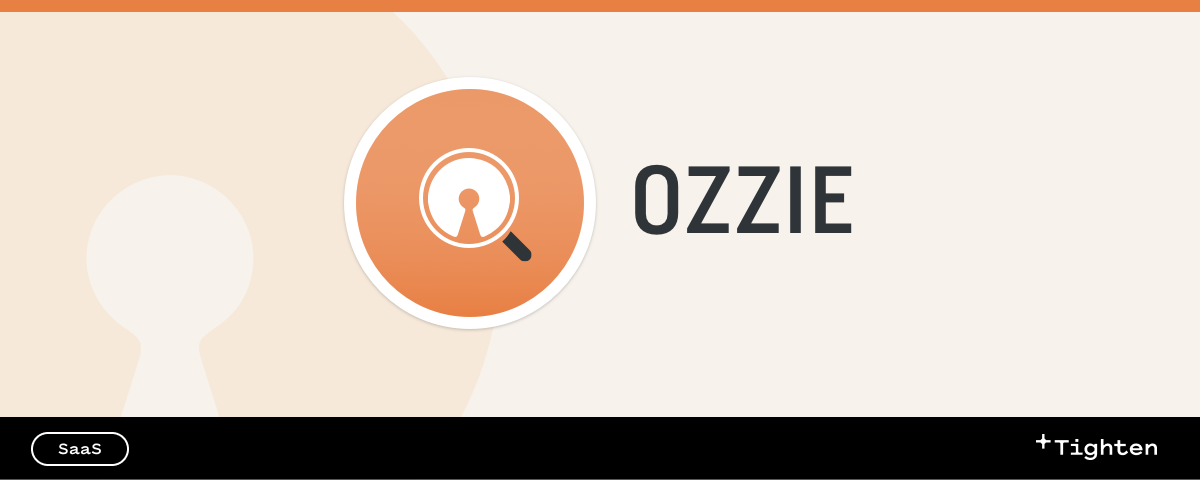Ozzie
Ozzie is Tighten's open source projects monitor. Each project is assigned a "debt score" based on how many open issues/PRs there are, and how old they are.
Local Installation
- Clone the repo (
git clone git@github.com:tighten/ozzie.git && cd ozzie) - Install dependencies (
composer install && npm install) - Create a GitHub OAuth Application. If you use Valet to serve your application locally, you can use the following settings:
- Application Name:
Local Ozzie - Homepage URL:
http://ozzie.test - Application Description:
Local Version of Ozzie - Authorization Callback URL:
http://ozzie.test/callback
- Application Name:
- Copy the example
.envfile:cp .env.example .envand modify its settings to match your local install, including the client ID and secret from the previous step - Create a database table (by default
.envlooks for one namedozzie) and run the migrations (php artisan migrate) - Copy
projects.json.disttoprojects.jsonand modify it for your organization. This list is used to initially seed theprojectstable - Fetch your projects' stats for the first time using
php artisan stats:fetch
Note: If you're not using a tool like Laravel Valet, run
php artisan serveand visit your site at http://127.0.0.1:8000; you'll also want to modify your GitHub app settings to use http://127.0.0.1:8000 instead of http://ozzie.test
Local Development with Docker
Ozzie contains a full Docker configuration to get started quickly with Docker. For more information on Docker, click here. To use Docker to host Ozzie you will need the following:
- Docker Desktop
- docker-compose (if not packaged with Docker desktop)
The installation steps are as follows:
- Clone the repo (
git clone git@github.com:tighten/ozzie.git && cd ozzie) - Run docker-compose inside the repository root directory (
docker-compose up) or (docker-compose up -dto run as daemon) - Install dependencies inside the PHP container:
- SSH into the container with
docker exec -it ozzie_php - Once inside, run composer
composer install
- SSH into the container with
- From outside the container, in the repository root run Javascript dependencies (
npm install) - From inside the container, you need to generate a self-signed SSL certificate:
- Navigate to
./docker/nginx/ssl - Use openSSL to generate a new certificate that uses the config (
openssl req -config openssl.cnf -new -sha256 -newkey rsa:2048 -nodes -keyout self-signed.key -x509 -days 365 -out self-signed.crt) - The new certificate will be picked up by Nginx
- Navigate to
- Create a GitHub OAuth Application. If you use Valet to serve your application locally, you can use the following settings:
- Application Name:
Local Ozzie - Homepage URL:
http://ozzie.test - Application Description:
Local Version of Ozzie - Authorization Callback URL:
http://ozzie.test/callback
- Application Name:
- Copy the example
.envfile:cp .env.example .envand modify its settings to include the GitHub OAuth keys you created in the previous step. - Change your
.envfile to point to the MySQL container settings:
DB_CONNECTION=mysql
DB_HOST=127.0.0.1
DB_PORT=3306
DB_DATABASE=ozzie
DB_USERNAME=laravel
DB_PASSWORD=password
- Run the migrations inside the container (
php artisan migrate) - Copy
projects.json.disttoprojects.jsonand modify it for your organization. This list is used to initially seed theprojectstable - Fetch your projects' stats for the first time using
php artisan stats:fetch
Projects and Daily Caching
Your list of projects is initially defined by the projects.json file in your app root. If you don't create one, the system will fall back to projects.json.dist, which also serves as a helpful template for you to create your own projects.json file.
Here's what the structure of the file looks like:
[
{
"name": "ziggy",
"namespace": "tighten",
"packagist": "tightenco/ziggy",
"maintainers": [
"mattstauffer"
]
},
]You can see you'll define the GitHub namespace, the GitHub project name, and the GitHub usernames of all of its maintainers.
Changing or Adding Projects
The list of projects resides in projects.json, and is seeded to the projects table using database/seeds/ProjectsSeeder.php. This means that any changes to projects needs to happen in projects.json first. Migrating and seeding tables fresh will update the projects table with the new info, and the next call of php artisan stats:fetch will re-populate project stats.
- Make a change to
projects.json - Drop and re-migrate all tables:
php artisan migrate:fresh --seed - Fetch all project stats:
php artisan stats:fetch
Daily Caching
Every time the php artisan stats:snapshot command is run, it captures the scores for each project (for historical comparison).
If you're using the scheduler, it'll already be scheduled to run every day (see the docs for how to set up the scheduler cron job).
By default, re-running the command on the same day will not update the day's existing snapshots. To override this behavior, use the -f flag, which will both create any missing snapshots for the day and update all existing snapshots for the day.
php artisan stats:snapshot -fLocal Development
Compiling the Frontend Assets
Use Laravel Mix to automatically compile JS/CSS on save:
npm run watchRunning the Linter Tools
This project uses PHP-CS-Fixer to fix PHP, Prettier to fix JS, and StyleLint to lint & fix CSS.
To automatically fix PHP:
composer fixTo automatically fix JS:
npm run fix-jsTo automatically fix CSS:
npm run fix-cssContributing
Please see CONTRIBUTING for details.
Credits
License
The MIT License (MIT). Please see LICENSE for details.
